The Museum of Stokes Croft, Bristol | reviews, news & interviews
The Museum of Stokes Croft, Bristol
The Museum of Stokes Croft, Bristol
A cabinet of urban curiosities marks a thriving alternative arts scene
Bristolians were invited to make history last weekend. The city saw the opening of the Museum of Stokes Croft, a one-room cabinet of contemporary urban curiosities that includes fake neighbourhood relics and archaeological finds, an early Banksy T-shirt, a large, totemistic multi-coloured bear full of mirrored surfaces by street sculptor Jamie Gilman, a cheap plastic urn containing the ashes of “Bear” - a popular homeless street poet who died last year - evocative children’s drawings of local landmarks, quirky fragments of oral history, politically tinged poems, and a map of Bristol’s world-famous underground music scene drawn by Japanese fans, complete with red pencil improvements from “Fat Paul” Horlick, a local music impresario and owner of the Croft, a cutting-edge nightspot a few doors down.
The event was a big hit and there were queues outside (the Museum can’t accommodate more than a dozen visitors at a time), and the opening night crowd included local culture heroes Daddy G of Massive Attack, revered photographer Beezer, chronicler of Bristol’s music scene and George Ferguson, architect and social entrepreneur and prime force behind Bristol’s famed Tobacco Factory, a key element in the cultural development of South Bristol.
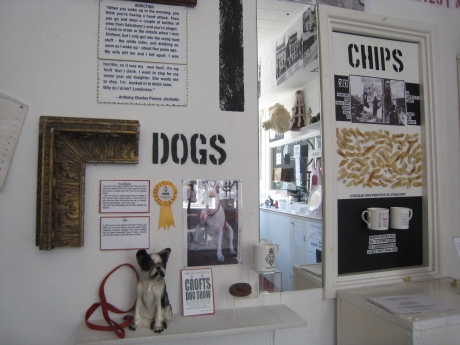 The Museum of Stokes Croft is the latest in a number of startling and often witty subversive actions that define the cultural life of this predominantly scuzzy area and draw in camera-toting tourists from Japan as well as day-trippers from Somerset. Stokes Croft’s main visitor attraction is Banksy’s imposing mural The Mild Mild West (main picture), featuring a cuddly teddy bear flinging a Molotov cocktail at a posse of riot police. The area is also home to busy massage parlours employing sex workers from Eastern Europe, a dense network of thriving artists’ studios, Bristol’s only anarchist bookshop, and some of the city’s most famous music clubs - the Lakota, the Blue Mountain and the Croft.
The Museum of Stokes Croft is the latest in a number of startling and often witty subversive actions that define the cultural life of this predominantly scuzzy area and draw in camera-toting tourists from Japan as well as day-trippers from Somerset. Stokes Croft’s main visitor attraction is Banksy’s imposing mural The Mild Mild West (main picture), featuring a cuddly teddy bear flinging a Molotov cocktail at a posse of riot police. The area is also home to busy massage parlours employing sex workers from Eastern Europe, a dense network of thriving artists’ studios, Bristol’s only anarchist bookshop, and some of the city’s most famous music clubs - the Lakota, the Blue Mountain and the Croft.
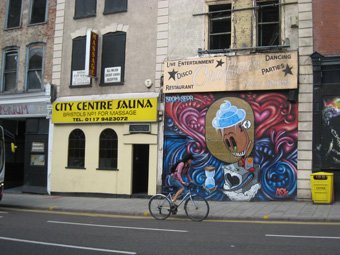 The area’s connection with entertainment goes back to the 18th century and the inglorious days of Bristol’s slave trade-driven gold rush. The neighbourhood lay on the outskirts of town beyond the reach of moral rectitude: a playground of brothels, taverns, circuses and musical theatres where merchants could exorcise the guilt of dubious business dealings. Not so long ago, when sheep and cattle were sold less than a mile away, West Country farmers would sneak up to Stokes Croft to waste a little of their livestock profits on sex and other pleasures of the flesh. Still perceived by many as a dangerous place, the street is now a major thoroughfare for commuters, few of whom are aware that this stretch of town has become a hive of cultural activity.
The area’s connection with entertainment goes back to the 18th century and the inglorious days of Bristol’s slave trade-driven gold rush. The neighbourhood lay on the outskirts of town beyond the reach of moral rectitude: a playground of brothels, taverns, circuses and musical theatres where merchants could exorcise the guilt of dubious business dealings. Not so long ago, when sheep and cattle were sold less than a mile away, West Country farmers would sneak up to Stokes Croft to waste a little of their livestock profits on sex and other pleasures of the flesh. Still perceived by many as a dangerous place, the street is now a major thoroughfare for commuters, few of whom are aware that this stretch of town has become a hive of cultural activity.
The area’s marginality reflects its geographical position between predominantly African-Caribbean St Pauls, decidedly bohemian Montpelier and more conventionally middle-class Cotham and Kingsdown. The edgy quality of Stokes Croft also owes a great deal to the co-existence of the addicts and the homeless with the helping professionals and religious proselytizers who offer support or salvation. There is a large Salvation Army establishment, the well-endowed and happy-clapping Church of Elim and a block-long homeless hostel. There are many others who have come to the area because of its liminal vibe – not just the artists, but social activists as well, all of whom are opposed to the developers who would turn this run-down piece of Bristol into fast profit: Co-Exist, a collective, have taken over Hamilton House, a soulless former office block which they have reanimated as an arts and community centre which boasts Bristol’s trendiest café, restaurant and music venue - The Canteen, a low-rent rendezvous for the city’s switched-on bohos, neo-hippies and environmental campaigners.
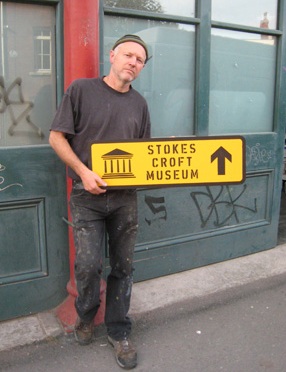 Across the road from Hamilton House, next to Jamaica Street Studios, one of the city’s most vibrant artists’ collectives, are the headquarters of the People’s Republic of Stokes Croft (PRSC), the eccentric but now well-established invention of Chris Chalkley (pictured right), the driving force behind the creation in Stokes Croft of what he calls an “outdoor art gallery”. Chalkley, who – perhaps fittingly – used to sell monkey puppets at festivals, is a mixture of trickster and benign dictator, as befits the ruler of a fictitious people’s republic. He is a constant irritant to the local council, part jester, part agitator, and his anarchic mono-mania has not always endeared him to others in the community. But this latter-day Situationist gets things done, promotes street art in the area, gets the homeless sweeping, gardening and painting, and was the enabler for the Museum project that was dreamt up by his collaborator Katy Bauer.
Across the road from Hamilton House, next to Jamaica Street Studios, one of the city’s most vibrant artists’ collectives, are the headquarters of the People’s Republic of Stokes Croft (PRSC), the eccentric but now well-established invention of Chris Chalkley (pictured right), the driving force behind the creation in Stokes Croft of what he calls an “outdoor art gallery”. Chalkley, who – perhaps fittingly – used to sell monkey puppets at festivals, is a mixture of trickster and benign dictator, as befits the ruler of a fictitious people’s republic. He is a constant irritant to the local council, part jester, part agitator, and his anarchic mono-mania has not always endeared him to others in the community. But this latter-day Situationist gets things done, promotes street art in the area, gets the homeless sweeping, gardening and painting, and was the enabler for the Museum project that was dreamt up by his collaborator Katy Bauer.
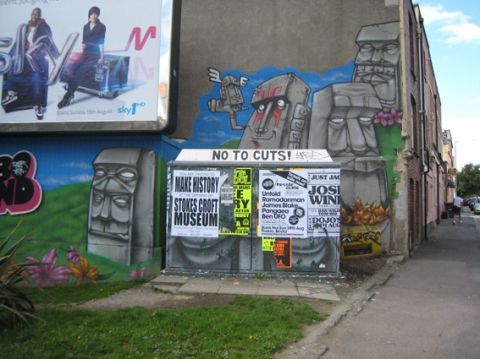 The Museum is positioned on a 200-yard stretch of Stokes Croft which features Chris Chalkley’s earlier imaginative subversions of a severely run-down shopping street: sandwiched between “Slix”, an ultra-cheap burger joint and “Anointed Touch”, one of Bristol’s most popular African-Caribbean hairdressers, Chalkley commissioned the painting of a trompe l’oeil shop front, an impressionistic and slightly dark “Mrs Lovett’s Meat Pie Shop”, on a hoarding that sits, appropriately given the reference to the demon barber, between the meat and hair businesses on either side.
The Museum is positioned on a 200-yard stretch of Stokes Croft which features Chris Chalkley’s earlier imaginative subversions of a severely run-down shopping street: sandwiched between “Slix”, an ultra-cheap burger joint and “Anointed Touch”, one of Bristol’s most popular African-Caribbean hairdressers, Chalkley commissioned the painting of a trompe l’oeil shop front, an impressionistic and slightly dark “Mrs Lovett’s Meat Pie Shop”, on a hoarding that sits, appropriately given the reference to the demon barber, between the meat and hair businesses on either side.
Next to the hair place, Chalkley has revamped the exterior of a vacant store by creating a fictitious “Apothecaire” that offers “coca”, “diamorphine” and a host of mind-altering substances. Along with the drug references, the fantasy store displays one of Chalkley’s favourite quotes, from Tacitus: “Coruptissima republica, plurimae leges” (“the more laws there are, the more corrupt the republic”). Chalkley thumbs his nose at what Situationist Guy Debord called “la société du spectacle”, by creating his own street spectacle. The Museum next door is yet another intervention designed to awaken the passer-by and transform the grimness of the city into something playful, imaginative and political.
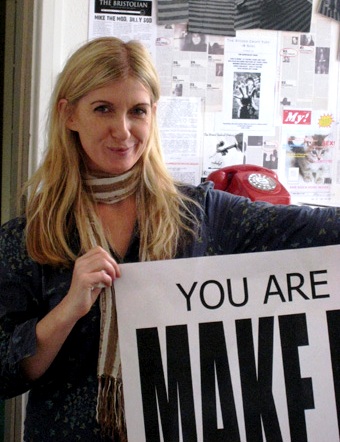 “It is hard to define what the Museum is,” Chalkley concedes, adding that “it fits the bill as a fine art installation – it’s like a visual newspaper and a polemic”. Katy Bauer (pictured right), the Museum’s effervescent creator and curator, is a former journalist and novelist from South Africa where she wrote for the Mail and Guardian, the first newspaper to oppose apartheid. “The PRSC pressed all my buttons,” Bauer says. “It was about creativity, independence and disregard for the status quo.”
“It is hard to define what the Museum is,” Chalkley concedes, adding that “it fits the bill as a fine art installation – it’s like a visual newspaper and a polemic”. Katy Bauer (pictured right), the Museum’s effervescent creator and curator, is a former journalist and novelist from South Africa where she wrote for the Mail and Guardian, the first newspaper to oppose apartheid. “The PRSC pressed all my buttons,” Bauer says. “It was about creativity, independence and disregard for the status quo.”
A former punk and squatter, she could relate to the area’s mix of homelessness, destitution, politics and art. She also knew that the range of artistic talent displayed in Stokes Croft’s vibrant mural work was not something which could be “sold” in the market-place: “There is all this vibrancy in Stokes Croft, but everything here is a labour of love. As there is no commercial reward, it’s seen as without value. That is why we need a museum”, she adds passionately, “as then it will be taken seriously.”
While the idea of a museum might carry weight, the contents of Bauer’s unique creation feature an unashamedly light and yet dark mix of the social, political, surreal and satirical. Bauer describes herself as an “outsider”, and the Museum is a piece of “outsider” museology, with a mixture of freshness, naivety and conscious ineptness that possess a vitality absent from well-funded institutions. Kate Bauer’s Museum gets no Arts Council funding: all the work is voluntary, only the rent is covered by a private supporter.
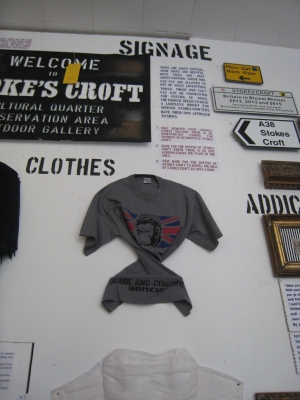 The rebellious impulse behind the Museum has a sometimes irritating pranksterish feel to it – not unlike the adolescent quality of some of Banksy’s work. Playfulness is a mixed blessing in art as it is in politics. It takes a while to take in the more earnest subtexts which run through the Museum’s often jokey displays.
The rebellious impulse behind the Museum has a sometimes irritating pranksterish feel to it – not unlike the adolescent quality of some of Banksy’s work. Playfulness is a mixed blessing in art as it is in politics. It takes a while to take in the more earnest subtexts which run through the Museum’s often jokey displays.
“What I want to establish here”, Bauer says, “is a living archive.” She is recording a constant stream of local lore: “My friend Sylvie, who owned Screen-One the T-Shirt, the place that did Banksy’s stuff, used to watch the street, and there used to be this woman who walked by either dressed as a bride or dressed as a bear.” For people-watchers, Stokes Croft has always offered constant and often surreal street theatre. The Museum includes an observation platform, from which visitors can survey the street, a comment in its own way on the omnipresence of police cameras that watch over the area.
The DIY quality of the Museum of Stokes Croft is pure Bristol, a city in which the undoubtedly brilliant musical experiments of the last 25 years have been fuelled by the city’s unique mixture of punk, hippie, laid-back African-Caribbean “going with the flow” attitude. The resolutely anti-commercial and gently anarchic stance that characterise the city’s street culture promotes playfulness, collaboration and experiment. The new Museum and the growth of Stokes Croft, as one of the UK’s first “outdoor galleries”, without a penny’s help from the local council or other institutions, are manifestations of a locally sourced culture.
This may seem out of place and time in a predominantly money-based environment, but the street-based ferment in Stokes Croft provides a counterblast to grandiloquent ideas about the Big Society or the quick-fix highs of an increasingly digitalised culture.
- Find out more about the Museum of Stokes Croft on the official website
Add comment
more Visual arts
 Eye to Eye: Homage to Ernst Scheidegger, MASI Lugano review - era-defining artist portraits
One of Switzerland's greatest photographers celebrated with a major retrospective
Eye to Eye: Homage to Ernst Scheidegger, MASI Lugano review - era-defining artist portraits
One of Switzerland's greatest photographers celebrated with a major retrospective
 Stephen review - a breathtakingly good first feature by a multi-media artist
Melanie Manchot's debut is strikingly intelligent and compelling
Stephen review - a breathtakingly good first feature by a multi-media artist
Melanie Manchot's debut is strikingly intelligent and compelling
 Fantastic Machine review - photography's story from one camera to 45 billion
Love it or hate it, the photographic image has ensnared us all
Fantastic Machine review - photography's story from one camera to 45 billion
Love it or hate it, the photographic image has ensnared us all
 Yinka Shonibare: Suspended States, Serpentine Gallery review - pure delight
Weighty subject matter treated with the lightest of touch
Yinka Shonibare: Suspended States, Serpentine Gallery review - pure delight
Weighty subject matter treated with the lightest of touch
 Jane Harris: Ellipse, Frac Nouvelle-Aquitaine MÉCA, Bordeaux review - ovals to the fore
Persistence and conviction in the works of the late English painter
Jane Harris: Ellipse, Frac Nouvelle-Aquitaine MÉCA, Bordeaux review - ovals to the fore
Persistence and conviction in the works of the late English painter
 Sargent and Fashion, Tate Britain review - portraiture as a performance
London’s elite posing dressed up to the nines
Sargent and Fashion, Tate Britain review - portraiture as a performance
London’s elite posing dressed up to the nines
 Zineb Sedira: Dreams Have No Titles, Whitechapel Gallery review - a disorientating mix of fact and fiction
An exhibition that begs the question 'What and where is home?'
Zineb Sedira: Dreams Have No Titles, Whitechapel Gallery review - a disorientating mix of fact and fiction
An exhibition that begs the question 'What and where is home?'
 Yoko Ono: Music of the Mind, Tate Modern review - a fitting celebration of the early years
Acknowledgement as a major avant garde artist comes at 90
Yoko Ono: Music of the Mind, Tate Modern review - a fitting celebration of the early years
Acknowledgement as a major avant garde artist comes at 90
 Unravel: The Power and Politics of Textiles in Art, Barbican review - the fabric of dissent
An ambitious exploration of a neglected medium
Unravel: The Power and Politics of Textiles in Art, Barbican review - the fabric of dissent
An ambitious exploration of a neglected medium
 When Forms Come Alive, Hayward Gallery review - how to reduce good art to family fun
Seriously good sculptures presented as little more than playthings or jokes
When Forms Come Alive, Hayward Gallery review - how to reduce good art to family fun
Seriously good sculptures presented as little more than playthings or jokes
 Entangled Pasts 1768-now, Royal Academy review - an institution exploring its racist past
After a long, slow journey from invisibility to agency, black people finally get a look in
Entangled Pasts 1768-now, Royal Academy review - an institution exploring its racist past
After a long, slow journey from invisibility to agency, black people finally get a look in
 Barbara Kruger, Serpentine Gallery review - clever, funny and chilling installations
Exploring the lies, deceptions and hyperbole used to cajole, bully and manipulate us
Barbara Kruger, Serpentine Gallery review - clever, funny and chilling installations
Exploring the lies, deceptions and hyperbole used to cajole, bully and manipulate us

Comments
Posting you a sonnet you